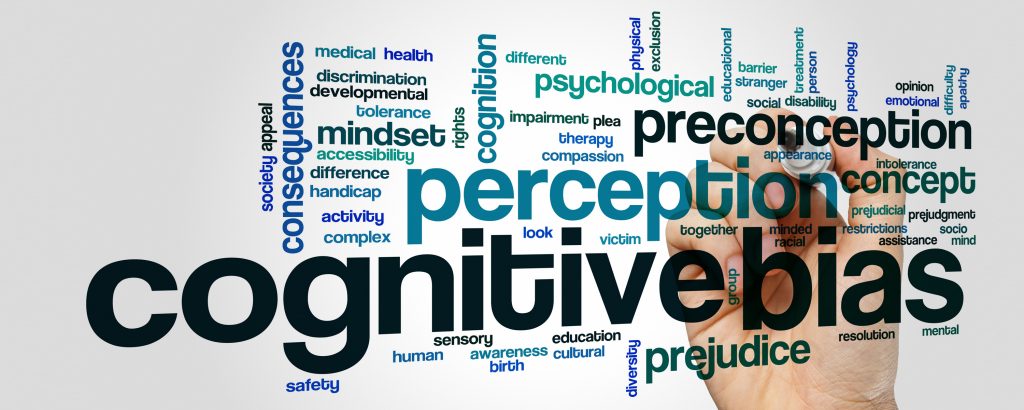Hiring bias has existed since recruiting for jobs began. Some bias was out-and-out discrimination, i.e., the refusal to hire people of color, women, veterans, people with disabilities and so on. Laws now exist to prevent and penalize discrimination in the hiring process but unconscious bias is tougher to eliminate.
What is Unconscious Bias?
Unconscious bias or implicit bias is prejudice or unsupported judgment for or against another person that isn’t deliberate. Researchers suggest that unconscious bias occurs automatically due to the brain making quick judgments based on past experiences and background. These experiences include how we were brought up and socialized, our exposure to diversity and media that feed into our decision-making.
Although we all have biases, many unconscious biases tend to be exhibited toward minority groups based on factors such as class, gender, sexual orientation, race, ethnicity, nationality, religious beliefs, age, disability and more. Hiring someone based on a “gut” feeling is a type of unconscious bias.
Assuming a Gen Z candidate will have more computer experience is another example of unconscious bias. Or subconsciously sorting candidates with Anglo-sounding names is also unconscious bias. Bias, unconscious or not, can cost companies big time.
How Hiring Bias Creates Compliance Infractions
Any type of hiring bias, whether done consciously or unconsciously, is against the law. The Equal Employment Opportunity Commission (EEOC) prohibits discrimination by employers on the bases of:
- Age
- Disability
- Equal Pay/Compensation
- Genetic Information
- Harassment
- National Origin
- Pregnancy
- Race/Color
- Religion
- Retaliation
- Sex
- Sexual Harassment
Failure to comply with the law, can cost you in penalties and lawsuits. Consider how Walmart, Inc. was made to pay $20 million to settle a company-wide, sex-based hiring discrimination lawsuit filed by the EEOC. The lawsuit stated Walmart conducted a physical ability test as a requirement for workers at its grocery distribution centers.
The EEOC said the test disproportionately excluded female applicants from jobs as grocery order fillers, violating Title VII of the Civil Rights Act of 1964 which prohibits employment discrimination based on sex, including the use of tests that cause a discriminatory impact on persons. The lawsuit further stated that tests such as the ones Walmart used, must prove the practices are necessary for the safe and efficient performance of specific jobs.
But, even if this necessity is proven, such tests are prohibited if it is shown there are alternative practices that can achieve the employer’s objectives but have a less discriminatory effect.
Four Types of Bias Common in Recruiting and Hiring
There are several types of biases in recruiting. Here are four of the most common.
Conformity Bias
Conformity bias is based on how people take cues from others on how to behave or act, rather than exercising their own judgement. It can happen due to peer pressure or the need to fit in at work. In terms of recruiting, conformity bias can persuade hiring managers to choose candidates based on who everyone else wants, instead of who they think is best.
Halo Effect
The halo effect is a stereotype where an overall impression of a person influences how we feel and think about their character. Perceptions of a single trait, like attractiveness, carries over to other aspects, like intelligent, funny and so on. For example, you find someone extremely attractive and automatically think they are nice and smart, even overlooking the fact they are the complete opposite. This bias creates a problem during recruiting as the recruiter may not take all of a candidate’s traits into account, even the red flags, instead only focusing on the one that’s blindsided them.
Affinity Bias
Affinity bias is the unconscious tendency to get along with others who are like us. The thought is that it is easier to get along with people we have something in common with than it is with those who are different. That is because it is easy to socialize and spend time with others who are the same. It requires more effort or work to bridge differences when diversity is present. In recruitment, hiring managers may choose candidates simply based on attending the same school or knowing the same people, which isn’t relevant to their ability to do the job.
Affect Heuristics
The affect heuristic is a bias where people take mental shortcuts to reach a conclusion about a person. This bias can be heavily influenced by current emotions. Your emotional response plays a critical role in decision-making. For example, a recruiter might be in a bad mood and quickly judge a candidate based on superficial factors like their size, choice of clothes, tattoos and even if they have the same name as someone they dislike.
How to Remove Unconscious Bias from the Hiring Process

While unconscious bias is widespread, that doesn’t mean hiring managers can’t take steps to decrease its effect.
- Be Aware of Unconscious Bias. According to an article in the Harvard Business Review, the first thing you can do to remove unconscious bias from the hiring process is accept that you have biases. No matter if you’ve proposed actions to increase diversity or are from an underrepresented community yourself, biases exist that will ultimately affect hiring decisions. This is especially true for affinity bias; favoring a candidate who is like us. Since hiring someone who looks, talks or acts like you is an easy trap to fall into, hiring managers have to recognize it exists and address it head on.
- Reduce Influence. One of the traps of conformity bias is being influenced by others. Keeping the lines of communication open is typically a great idea but giving your opinion about a candidate before others developed their own can lead to bias. To counteract conformity bias, Microsoft made its feedback private, only allowing hiring managers to see the opinions of others, after they made their own assessment first.
- Use a “Flip it to Test” Approach. One way to test unconscious bias during hiring is to use the “flip it to test” approach. The approach works by asking yourself if you’d feel the same way about a candidate from an underrepresented background if they were similar to your typical hires. For example, if you had concerns about hiring a black woman, would those same concerns still be present if the candidate was a white male?
- Remove Bias in Job Descriptions. Remove all language that could lead to hiring a candidate based on their gender. Write job descriptions that don’t use gender-biased language like guys, he or she. Use gender-neutral language like “the candidate” or “the applicant.” Job description writers should also be aware of masculine skewed language, like ambition, driven and competitive, and feminine skewed language, like thoughtful, flexible and trustworthy and try to eliminate or reduce their use.
- Reward Referrals of Diverse Candidates. Employee referral programs are great, they account for a greater number of high-quality hires, but if your current workforce is made up of people who are all alike, they’ll likely refer someone who looks or acts just like them, leading to affinity bias. Give employees incentives for referring candidates from backgrounds that are different from their own.
- Give Work Sample Tests. Another way to gauge whether the candidate you’ve chosen is best for the job is to give a work sample test. These tests are more accurate than personality or aptitude tests and don’t rely on insignificant work factors, like age, gender or race. Ask candidates to solve work-related problems or take a skills test to determine future job performance.
- Use AI in Recruiting. AI can help eliminate unconscious bias. When the parameters are set correctly, i.e., targeting candidates based on education or skills needed, AI can make finding and sorting candidates fair. AI doesn’t read names, age, gender and so on, unless it is programmed to do so. AI also reduces the amount of time hiring managers need to sort resumes, allowing more qualified applicants to make it into the funnel. Think about how many resumes are discarded just because the recruiter doesn’t have enough time to review them all. AI has the ability to sort through all the resumes you receive, putting more diverse candidates in front of you.
Automating your recruiting efforts with an Applicant Tracking System that utilizes AI can reduce unconscious bias and keep your company compliant. Arcoro’s Recruiting AI and Texting not only helps you communicate with candidates 24/7 but screen candidates based on a customizable set of questions with learned responses, not biases.
Arcoro’s AI can be programmed to sort candidates based on location, education, skills and other parameters, without judging candidates on race, gender, sexual orientation and so on. Plus, once qualified candidates meet your criteria, the AI assistant improves the candidate experience by keeping the lines of communication open. AI will answer questions, schedule interviews and more.
Arcoro’s AI benefits both managers and candidates by:
- Scheduling interviews. The program will integrate internal calendars with your assistant to automatically schedule candidate interviews. Rescheduling is also available if needed for the candidate or hiring manager.
- Sharing company information. The AI assistant continually learns about your company, giving it the ability to answer questions, directing candidates to your online application.
- Deploying outbound campaigns. Use the assistant to recruit for upcoming staffing needs by sending customized messages to thousands of contacts within minutes.
- Pre-screening candidates. Configure your pre-qualifying questions to screen candidates as they interact with your assistant. Top candidates receive expedited interview invitations.
- Gathering candidate information faster. Candidates can interact with your recruiting assistant via web or text-based chats to find information.
- Gathering employee referrals. Employees can refer a friend to job openings by texting the name and number to your recruiting assistant.
Once the candidate applies, Arcoro’s ATS automatically stores their application and resume, allowing hiring managers to track good faith efforts with automated compliance reporting on AAP, VEVRAA Section 503 and more. Our ATS ensures you’re fully prepared in case of OFCCP and I-9 audits. Take our Free HR Assessment to see how your company’s recruiting efforts stack up.




